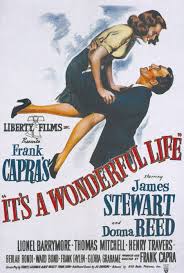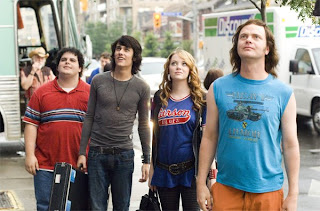Frank Capra's Wonderful Style
 by CJ
by CJAs is traditional for this time of year, I'm indulging myself in a self-made holiday "film fest."
I have some favorite traditional holiday movies, including Albert Finney's musical, Scrooge! and Cary Grant's The Bishop's Wife (neither to be confused with imitation re-makes) but one of my favorite film makers seemed especially drawn to the holidays, Frank Capra, so I went on a Capra-binge.
 For those of you who only know Capra for It's a Wonderful Life, you should be aware that Wonderful Life was actually one of his later movies. The culmination, if you will, of decades of telling David v. Goliath stories with the recurrent theme that he finally verbalizes in Wonderful LIfe: No man is poor if he has friends.
For those of you who only know Capra for It's a Wonderful Life, you should be aware that Wonderful Life was actually one of his later movies. The culmination, if you will, of decades of telling David v. Goliath stories with the recurrent theme that he finally verbalizes in Wonderful LIfe: No man is poor if he has friends.The New York Times recently did a wonderful deconstruction of Wonderful Life and I was taken by how film critic Wendell Jamieson's analysis mirrored my own.
Wonderful Life isn't really the magically uplifting movie we all think it is--or should I say, we all FEEL it is. And therein lies the magic of Capra.
He was one of the first filmmakers to use "real life" subject matter for his movies. His first major film, American Madness, was filmed during the Great Depression (as opposed to the Not-so-Great Recession we now find ourselves in) and told the story of a bank that has a run on it and is failing. It is saved because of the past actions of the good-hearted bank manager who had faith in "little people" when his friends call upon them to help him out in his time of need.
Shades of Wonderful Life--but many of Capra's films have shades of Wonderful Life in them. Even the music and words of Auld Lang Syne are repeated in several of his movies. His heroes are almost uniformally Davids caught unprepared for their Goliaths--they are innocents thrust into a dirty street fight that is the "real" world.
And Capra's heroines? They also follow a repeated theme of redemption. They begin as conniving, world-weary professional women (remember this is seventy years ago, the world of the 1930's and 40's!) who are redeemed by falling in love with the hero and embracing his idealistic ways.
These themes were repeated so often that the term Capraesque now means anything that evokes a feeling of an optimistic, "feel-good" movie genre, or what some critics call the genre of the "hopeless dreamer"
But one other recurrent theme in Capra's films--and what truly sets them apart from so many other filmmakers of his era--is that often his Goliaths are never defeated.
Yes, the hero wins--but he wins a battle, not the war.
 Potter in Wonderful Life is neither defeated nor redeemed. Nor is the Hearst-figure in Meet John Doe, or King Wesley in It Happened One Night.
Potter in Wonderful Life is neither defeated nor redeemed. Nor is the Hearst-figure in Meet John Doe, or King Wesley in It Happened One Night. Some nemesis figures are redeemed--Senator Payne in Mr. Smith Goes to Washington, the banker in You Can't Take it with You--but Capra always makes it clear that other Goliaths are waiting to fill their places, so the war is not won.
In fact, for Capra, the war is never won. Because it's never won in the real world that he takes his stories from.
He tempers his films with romance and humor to soften this blow, always ends them on an inspirational upbeat note for audiences to carry home, but in fact, he is the master propagandist, preparing his army and sending them off to war.
For a storyteller, this is an awesome power to behold. One that, as a writer, I covet!
What Capraesque moment, in the movies or in real life, has most moved you?
And what's your line-up for your own Holiday Film Fest?
Thanks for reading!
CJ
 About CJ:
About CJ:As a pediatric ER doctor, CJ Lyons has lived the life she writes about in her cutting edge suspense novels. Her debut, LIFELINES (Berkley, March 2008), became a National Bestseller and Publishers Weekly proclaimed it a "breathtakingly fast-paced medical thriller."
The second in the series, WARNING SIGNS, was released January, 2009 and the third, URGENT CARE, October, 2009. Contact her at http://www.cjlyons.net



Images courtesy of TV guide.com


Terrific post CJ! I love your analysis of Capra's films and his style. I think Jimmy Stewart really personified that "idealistic hero" so well in Capra's films - interesting how in later years Hitchcock used that persona that Stewart had created on screen and turned it on its ear in his films. I love watching musicals during the holidays - Sound of Music, Singin' in the Rain, My Fair Lady - like gobbling a delectable Christmas treat. Happy Holidays!
ReplyDeleteGreat post, CJ. It's a Wonderful Life is my favorite movie! I think the scene where they're both listening on the phone, and Jimmy Stewart finally grabs her and breaks down encapsulates what makes him a hero. In that moment, he realizes he's not going to achieve any of the goals he's set for himself, but also realizes what he has in his hands is far better.
ReplyDeleteJoanna, what fun to have a musical film-fest! Oh, the possibilities....hmmm, if I disappear for a while, you all will know why, lol!
ReplyDeleteCate,
ReplyDeleteI know, that's my favorite scene as well--and what makes him heroic is his humanity, no super-human alpha male bravado or feats of derring-do....interesting when you look at the heroes popular in today's pop culture.
I think I may be the only person left on the earth who has never seen It's A Wonderful Life.
ReplyDelete